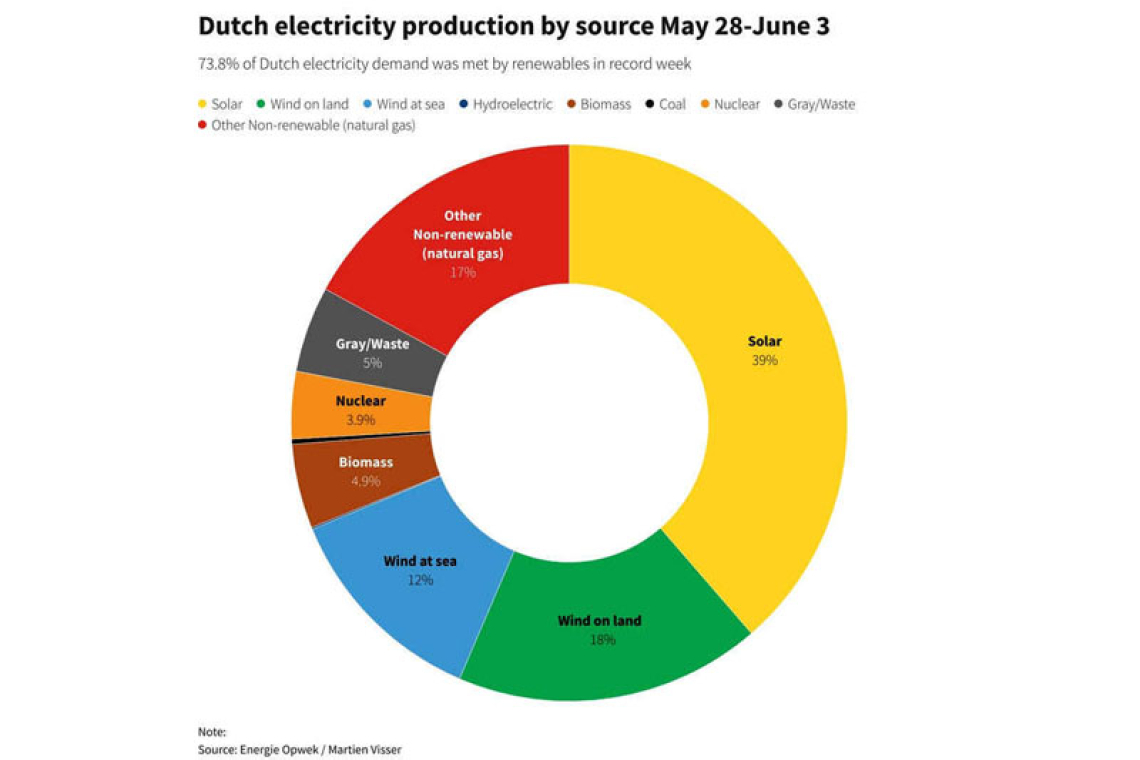Energie Opwek graphic
AMSTERDAM--A pandemic push and a subsidy surge have transformed the Netherlands from renewable energy laggard to Europe’s leading per capita user of solar panels, putting it on course to meet green goals after years of struggling.
While it faces growing infrastructure challenges to maintain the momentum, in May more than half of Dutch electricity and 20% of national energy was supplied by renewable sources. Both were firsts.
Compare that with 7.4% in 2018, when the country was the worst performer in Europe behind Malta, Eurostat figures show. The Netherlands missed 2020 goals but is on track to hit renewable and emission targets for 2030.
One reason is a government-led build out of wind turbine farms in the North Sea, the kind of large-scale engineering the Dutch are famed for. The bigger surprise was a tripling of solar energy during the COVID-19 pandemic, much of it on rooftops and farms.
“I think a lot of people are surprised by the fact that this country, famous for paintings of clouds, is actually now a solar leader,” Minister for Energy and Climate Minister Rob Jetten told Reuters in an interview, underlining that the Netherlands has challenges ahead.
Subsidies include a generous “net metering” system, which means users can deduct what they feed into the grid from their electricity usage.
Homeowner Linda Balk installed eight solar panels in 2021 on her roof in the southern Dutch town of Sint-Oedenrode and said the money she has saved on her energy bill has made a “huge difference”, especially when prices spiked following Russia’s 2022 invasion of Ukraine.
A major issue is adapting electrical grids. Grid company TenneT has said it will spend 100 billion euros on infrastructure in the coming decade, but more international interconnections are needed and project connections face unpredictable waits.
The Netherlands still trails China, the United States, Germany and Spain in overall solar generation, but it entered the global top 10 in 2022, according to industry body SolarPower Europe, adding 4.1 gigawatts (GW) for a total 18GW capacity. That makes the Dutch first in Europe and number two globally, behind Australia in solar capacity per person, as better, cheaper panels are driving the adoption of solar energy worldwide.
Martien Visser, a lecturer at Hanze University of Applied Sciences in Groningen, who collects and publishes data on the Dutch energy transition, said the subsidies behind the boom will become less generous. The net metering system will be gradually replaced by compensation based on spot prices, which are falling, sometimes to zero, during sunny hours, leading to some solar capacity being shut in.
Another pillar of Dutch renewable success has been North Sea wind, with 3.2GW total in 2022, and around 2GW being added annually for the coming decade. A 750-megawatt (MW) farm came online last week.
SolarPower Europe forecasts the Netherlands will also install around 4GW of solar annually through 2028.
With 1GW enough to supply roughly a million households with electricity, the country may have a surplus of green electricity, but most infrastructure relies on natural gas and oil for heating, transport and industrial needs.
Apart from grid improvements, batteries, hydrogen and other ways to store electricity are urgently needed. “Although there are a lot of projects on the drawing board, so far, hardly anything has been built,” Visser said.







